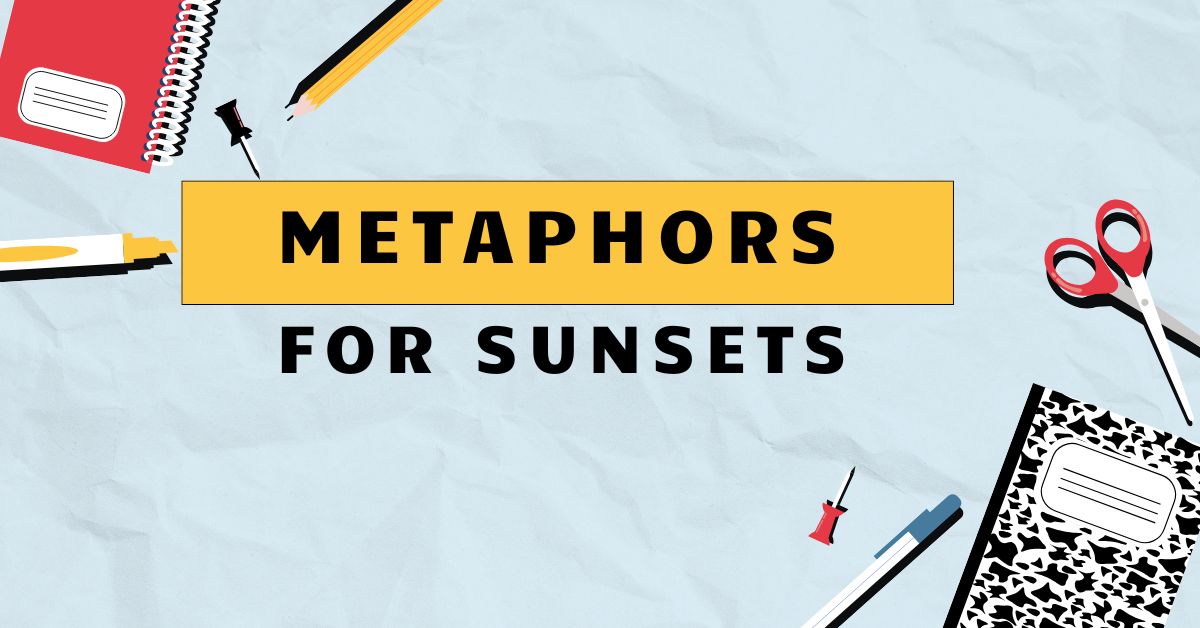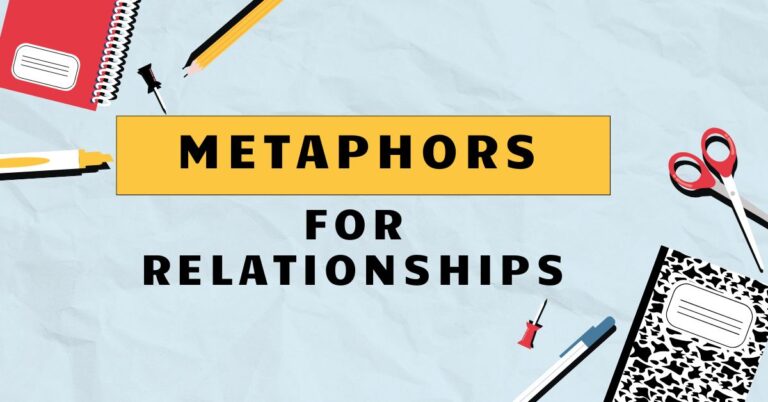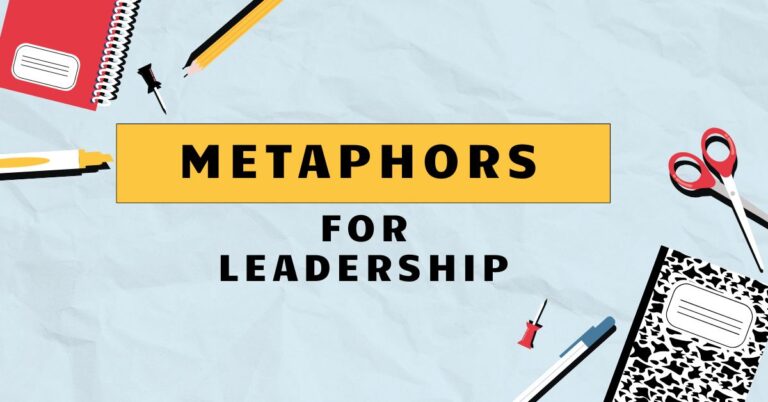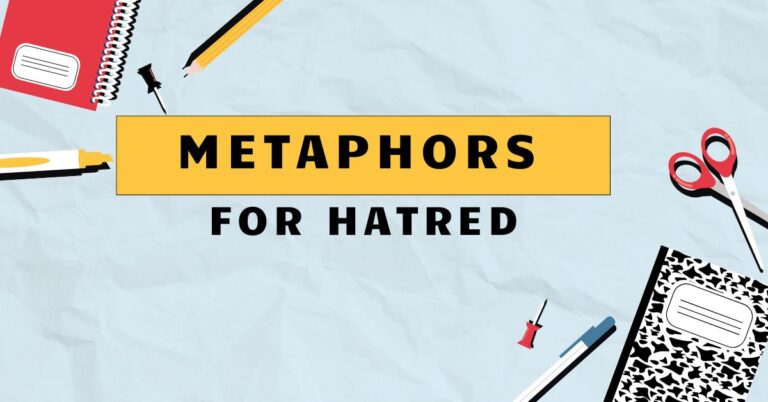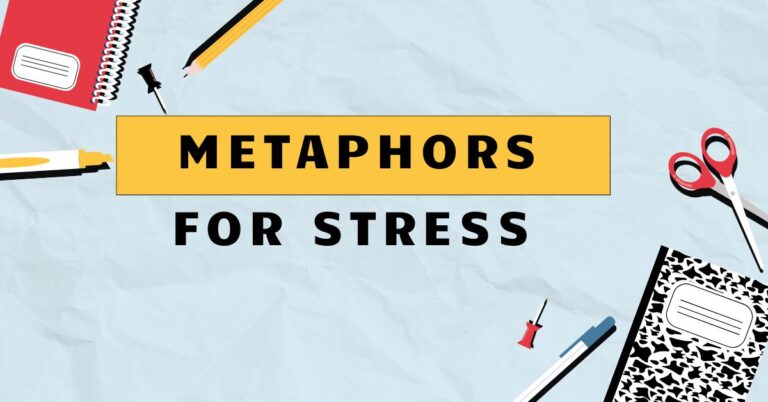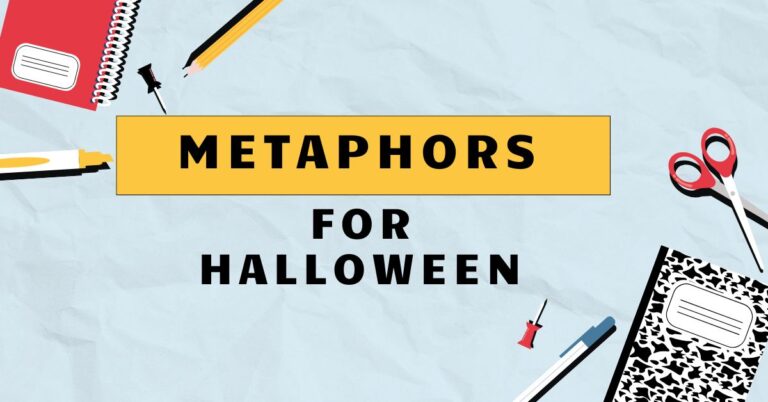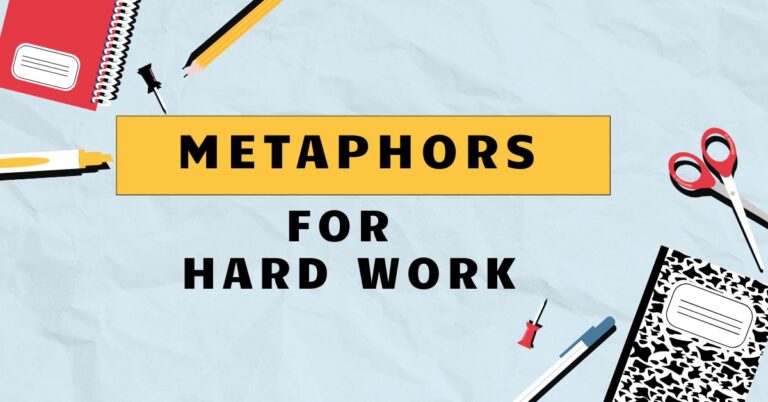39 Metaphors for Sunsets: A Comprehensive Guide
Sunsets have captivated humans for millennia, inspiring art, poetry, and prose. Understanding the metaphors used to describe sunsets not only enhances our appreciation of literature but also deepens our understanding of figurative language itself.
This article provides a comprehensive exploration of sunset metaphors, offering a structured approach to recognizing, interpreting, and using them effectively. This guide is designed for English language learners, creative writers, and anyone interested in enriching their descriptive vocabulary and linguistic skills.
Table of Contents
- Introduction
- Definition of Metaphor
- Structural Breakdown of Sunset Metaphors
- Types and Categories of Sunset Metaphors
- Examples of Sunset Metaphors
- Usage Rules for Sunset Metaphors
- Common Mistakes with Sunset Metaphors
- Practice Exercises
- Advanced Topics in Sunset Metaphors
- Frequently Asked Questions
- Conclusion
Definition of Metaphor
What is a Metaphor?
A metaphor is a figure of speech that directly compares two unrelated things without using “like” or “as.” It asserts that one thing *is* another, creating a vivid and often surprising connection. Metaphors are essential tools for writers and speakers seeking to add depth, color, and emotional resonance to their language.
They allow us to understand abstract concepts in terms of more concrete experiences.
Function of Metaphor
Metaphors serve several crucial functions in language. They can simplify complex ideas, making them more accessible and relatable.
They also add emotional impact, creating a stronger connection with the audience. Furthermore, metaphors can reveal new perspectives, prompting us to see things in a different light.
By forging unexpected links between disparate concepts, metaphors enrich our understanding and appreciation of the world around us.
Metaphors in the Context of Sunsets
Sunsets, with their dramatic colors and ephemeral nature, are a particularly rich source of metaphorical inspiration. They can represent endings, beauty, hope, or even the passage of time.
The specific metaphor chosen depends on the writer’s intent and the overall tone of the piece. For example, a sunset described as “a fiery kiss goodnight” evokes a sense of passion and closure, while a sunset depicted as “a bleeding wound on the horizon” conveys pain and loss.
The possibilities are endless, limited only by the imagination.
Structural Breakdown of Sunset Metaphors
Subject and Vehicle
Every metaphor consists of two key elements: thesubjectand thevehicle. The subject is the thing being described (in this case, the sunset).
The vehicle is the thing it is being compared to. The effectiveness of a metaphor hinges on the relationship between the subject and the vehicle.
A strong metaphor creates a clear and compelling connection, while a weak one may be confusing or ineffective. For example, in the metaphor “the sunset was a painter’s masterpiece,” the sunset is the subject, and a painter’s masterpiece is the vehicle.
Implicit and Explicit Metaphors
Metaphors can be either explicit or implicit. Anexplicit metaphordirectly states the comparison, often using a verb of being (e.g., “is,” “was,” “are”).
Animplicit metaphor, on the other hand, implies the comparison without directly stating it. Instead, it uses evocative language to suggest the connection.
For example, “the sky wept tears of orange and gold” is an implicit metaphor, as it doesn’t explicitly say the sunset *is* crying, but rather evokes that image through descriptive language.
Types and Categories of Sunset Metaphors
Color-Based Metaphors
Color-based metaphors focus on the vibrant hues of the sunset, comparing them to other colorful objects or phenomena. These metaphors often highlight the intensity and beauty of the sunset’s palette.
They can evoke a range of emotions, from joy and excitement to peace and tranquility. The specific colors mentioned and the objects they are compared to play a crucial role in shaping the overall impression.
Nature-Based Metaphors
Nature-based metaphors draw parallels between the sunset and other natural elements, such as fire, water, or flowers. These metaphors often emphasize the grandeur and power of nature, as well as the cyclical nature of life.
They can also create a sense of harmony and connection with the natural world. The choice of natural element depends on the specific qualities of the sunset being described.
Emotion-Based Metaphors
Emotion-based metaphors attribute human emotions to the sunset, personifying it and creating a more intimate connection with the reader. These metaphors can convey a wide range of feelings, from joy and hope to sadness and longing.
They often reflect the writer’s personal experiences and perspectives. The specific emotion chosen should align with the overall mood and tone of the piece.
Object-Based Metaphors
Object-based metaphors compare the sunset to man-made objects, such as paintings, jewels, or machines. These metaphors can highlight the artistry, value, or complexity of the sunset.
They often provide a unique and unexpected perspective, challenging the reader’s assumptions. The choice of object depends on the specific qualities of the sunset being emphasized.
Event-Based Metaphors
Event-based metaphors compare the sunset to specific occurrences or moments in time, such as a battle, a celebration, or a farewell. These metaphors can imbue the sunset with a sense of drama, significance, or nostalgia.
They often create a powerful and memorable image in the reader’s mind. The choice of event should be relevant to the overall theme and message.
Examples of Sunset Metaphors
The following tables provide extensive examples of sunset metaphors, organized by category. Each example illustrates a different way of describing the sunset, showcasing the versatility and power of metaphorical language.
Color Metaphor Examples
This table showcases various color-based metaphors used to describe sunsets. Notice how each metaphor evokes a different visual and emotional experience through its specific color associations.
| Metaphor | Explanation |
|---|---|
| The sunset was a river of molten gold. | Compares the sunset’s golden light to flowing liquid gold. |
| Crimson tears stained the clouds. | The red color is likened to tears, creating a sorrowful image. |
| The sky was an orange sherbet dream. | The sunset’s colors are compared to the sweet and creamy hues of orange sherbet. |
| The horizon bled into a violet bruise. | The fading light is likened to a bruise, suggesting pain or fading beauty. |
| The sun dipped below the horizon, painting the clouds with strokes of fiery coral. | The vibrant colors are portrayed as paint applied to the canvas of the sky. |
| The evening sky was a canvas of sapphire and rose. | The deep blues and soft pinks of the sky are compared to precious gemstones and delicate flowers. |
| The sunset was a kaleidoscope of ruby and amber. | The shifting colors are reminiscent of the patterns seen in a kaleidoscope. |
| The clouds were tinged with the blush of a thousand peaches. | The soft pink hues are compared to the delicate color of peaches. |
| A saffron glow enveloped the landscape. | The warm, golden-yellow color is likened to the spice saffron. |
| The sky burned with hues of scarlet and vermilion. | Intense red colors are used to describe the dramatic sunset. |
| The sunset was a tapestry woven with threads of bronze and copper. | Metallic colors are used to describe the rich and textured appearance of the sunset. |
| The heavens were adorned with streaks of lavender and lilac. | Soft purple shades are used to create a calming and serene image. |
| The sunset was a masterpiece of turquoise and teal. | Blue-green colors are used to depict a vibrant and captivating scene. |
| The clouds were edged with silver linings. | Bright, reflective light is highlighted, suggesting hope and optimism. |
| The sky glowed with the warmth of a golden amber. | A rich, warm color is used to evoke feelings of comfort and security. |
| Hues of rose madder painted the distant hills. | A deep, rich red color is used to add depth and intensity to the landscape. |
| The sky shimmered with the iridescent colors of an opal. | The changing, multicolored effect of an opal is used to describe the dynamic sunset. |
| The sunset was a wash of cerulean and cobalt. | Deep blue colors are used to create a vast and expansive feeling. |
| The sky was dusted with the faint pink of cherry blossoms. | Delicate pink hues are used to create a soft and romantic atmosphere. |
| The sunset was a fiery explosion of tangerine and gold. | Vibrant, energetic colors are used to describe a dramatic and intense sunset. |
| The clouds transformed into ribbons of platinum and pearl. | Luminous, shimmering colors are used to create an elegant and ethereal image. |
| The sunset painted the sky with the colors of a peacock’s feathers. | The vibrant and iridescent colors of peacock feathers are used to illustrate a colorful sunset. |
Nature Metaphor Examples
This table presents nature-based metaphors for sunsets. Each example connects the sunset with different elements of the natural world, emphasizing its beauty and power.
| Metaphor | Explanation |
|---|---|
| The sunset was a dying ember in the sky. | Compares the fading light to a dying fire. |
| The clouds were ships sailing on a sea of fire. | The clouds become ships, and the sunset becomes a fiery sea. |
| The sun sank like a ripe fruit into the earth. | The setting sun is likened to a ripe fruit, suggesting fullness and completion. |
| The sky was a blossoming garden of light. | The vibrant colors are compared to a garden in full bloom. |
| The sunset was a phoenix rising from the ashes of the day. | The sunset symbolizes rebirth and renewal. |
| The clouds were mountains ablaze with color. | The towering clouds are likened to mountains on fire. |
| The sun melted into the horizon like butter. | The sun’s descent is described as a smooth and gradual process. |
| The sky was a vast, shimmering ocean of light. | The expansive sky is compared to an endless ocean. |
| The sunset was a gentle exhale of the day. | The sunset is likened to a peaceful and calming breath. |
| The clouds were feathers scattered across the sky. | The light and airy clouds are compared to feathers. |
| The sun was a golden yolk dripping into the earth. | The sun’s shape and color are likened to a yolk. |
| The sunset was a fiery serpent slithering across the sky. | The dramatic sunset is compared to a powerful and dynamic serpent. |
| The sky was a field of wildflowers painted with light. | The vibrant colors are compared to a field of blooming flowers. |
| The sunset was a waterfall of molten gold. | The flowing light is likened to a cascading waterfall. |
| The clouds were waves crashing on the shore of the sky. | The dynamic clouds are compared to ocean waves. |
| The sun was a seed planted in the earth. | The setting sun symbolizes potential and new beginnings. |
| The sunset was a butterfly spreading its wings across the sky. | The colorful and expansive sunset is compared to a butterfly in flight. |
| The sky was a forest of light, with trees of fire. | The towering clouds and vibrant colors are compared to a forest ablaze. |
| The sunset was a river flowing into the night. | The fading light is likened to a river merging with darkness. |
| The clouds were petals falling from the sky. | The delicate and ephemeral clouds are compared to falling petals. |
| The sun was a lion retreating into its den. | The setting sun is depicted as a majestic lion seeking rest. |
| The sky was a canvas where the sun painted mountains of fire. | The vibrant colors are compared to mountains of fire. |
| The sunset was a flock of birds migrating to the horizon. | The setting sun is compared to birds flocking. |
Emotion Metaphor Examples
This table explores sunset metaphors that use emotions to describe the scene. These metaphors add a human element to the sunset, making it more relatable and evocative.
| Metaphor | Explanation |
|---|---|
| The sunset was a sigh of relief after a long day. | The sunset represents a feeling of peace and release. |
| The sky wept golden tears as the sun departed. | The sunset evokes sadness and longing. |
| The sunset was a passionate kiss goodnight. | The sunset represents love and affection. |
| The sky blushed with embarrassment as the sun hid its face. | The sunset is personified with feelings of shyness. |
| The sunset was a silent promise of a new dawn. | The sunset offers hope and anticipation for the future. |
| The sky roared with anger as the storm approached. | The sunset and impending storm evoke feelings of fury. |
| The sunset was a gentle lullaby whispering peace. | The sunset creates a sense of calm and tranquility. |
| The sky smiled with joy as the sun peeked through the clouds. | The sunset brings feelings of happiness and optimism. |
| The sunset was a melancholic farewell to summer. | The sunset evokes feelings of sadness and nostalgia. |
| The sky trembled with fear as darkness crept in. | The sunset and approaching night evoke feelings of anxiety. |
| The sunset was a hopeful whisper of better days. | The sunset offers encouragement and optimism. |
| The sky sulked with resentment as the clouds obscured the sun. | The sunset is personified with feelings of bitterness. |
| The sunset was a grateful embrace after a long journey. | The sunset represents comfort and relief. |
| The sky yearned with longing for the sun’s return. | The sunset evokes feelings of desire and anticipation. |
| The sunset was a determined stand against the encroaching night. | The sunset represents resilience and strength. |
| The sky sighed with contentment as the stars emerged. | The sunset creates a sense of satisfaction and peace. |
| The sunset was a shy glance before disappearing into darkness. | The sunset is personified with feelings of timidity. |
| The sky rejoiced with excitement as the first rays of dawn appeared. | The sunset and approaching sunrise evoke feelings of joy. |
| The sunset was a somber reflection on the day’s events. | The sunset evokes feelings of introspection and contemplation. |
| The sky glowed with pride as the moon ascended. | The sunset and moonrise evoke feelings of fulfillment. |
| The sunset felt like a warm hug after a freezing day. | The sunset brings a sense of comfort and relief. |
| The sunset was a sad song playing on the horizon. | The sunset evokes feelings of melancholy and loss. |
| The sunset was a sweet memory lingering in the sky. | The sunset evokes feelings of nostalgia and fondness. |
Object Metaphor Examples
This table provides examples of sunset metaphors that compare the sunset to various objects. These metaphors can add a unique and unexpected perspective to the description.
| Metaphor | Explanation |
|---|---|
| The sunset was a stained-glass window in the sky. | Compares the sunset’s colors to the vibrant hues of stained glass. |
| The clouds were brushstrokes on a celestial canvas. | The clouds become paint strokes, and the sky becomes a canvas. |
| The sun was a coin sinking into a velvet purse. | The setting sun is likened to a valuable coin disappearing into darkness. |
| The sky was a theater curtain closing on the day. | The sunset signifies the end of the day’s performance. |
| The sunset was a melting popsicle, dripping colors down the sky. | The sunset is compared to a sweet treat dissolving and spreading its colors. |
| The clouds were tapestries woven with light and shadow. | The clouds are likened to intricate and textured fabrics. |
| The sun was a golden button falling off the edge of the world. | The sun’s shape and color are compared to a button. |
| The sunset was a symphony of colors playing across the sky. | The vibrant colors are likened to a harmonious musical composition. |
| The sky was a kaleidoscope, constantly shifting and changing. | The dynamic colors are compared to the patterns seen in a kaleidoscope. |
| The clouds were origami sculptures folded from light. | The light and airy clouds are likened to delicate paper art. |
| The sun was a lantern being lowered into the sea. | The sun’s light is compared to a guiding lantern. |
| The sunset was a postcard from paradise. | The beautiful scene is likened to a memento of an idyllic location. |
| The sky was a jewelry box filled with glittering stars. | The night sky is compared to a treasure chest. |
| The clouds were kites dancing on the wind. | The light and airy clouds are likened to playful kites. |
| The sun was a clock winding down the day. | The setting sun symbolizes the passage of time. |
| The sunset was a painting hung in the gallery of the sky. | The beautiful scene is likened to a work of art. |
| The sunset was a giant disco ball, scattering light everywhere. | The vibrant colors are likened to a party atmosphere. |
| The sunset was a kaleidoscope of fractured dreams. | The vibrant colors are likened to a broken dream. |
| The sunset was a neon sign flashing its last message. | The vibrant colors are likened to an advertisement. |
| The sunset was a carousel of colors, spinning around the horizon. | The vibrant colors are likened to a carnival atmosphere. |
Event Metaphor Examples
This table presents sunset metaphors that compare the sunset to various events. These metaphors can add a sense of drama or significance to the description.
| Metaphor | Explanation |
|---|---|
| The sunset was a grand finale to a day’s performance. | Compares the sunset to the closing act of a show. |
| The clouds were dancers twirling in the twilight. | The clouds become performers, and the sunset becomes a stage. |
| The sunset was a painter’s last stroke on the canvas of day. | The sunset is likened to a final touch on a painting, signifying the end of the daylight. |
| The sunset was a battle between light and darkness. | The sunset is compared to a struggle between opposing forces, creating a sense of drama and tension. |
| The sun was a king abdicating his throne. | The setting sun is likened to a ruler stepping down from power, suggesting a transition of authority. |
| The sky was a celebration, fireworks of color exploding in the distance. | The vibrant colors are compared to the spectacle of a fireworks display, evoking joy and excitement. |
| The sunset was a silent film, each frame telling a story of the day. | The sunset is likened to a visual narrative, where each moment conveys the events of the day. |
| The clouds were ships returning home after a long voyage. | The clouds are compared to vessels completing a journey, suggesting a sense of completion and arrival. |
| The sunset was a symphony orchestra playing its final, fading notes. | The vibrant colors are likened to a musical performance ending, creating a feeling of closure. |
| The sun was an athlete passing the baton to the night. | The setting sun is likened to a relay race, suggesting a transfer of responsibility. |
| The sunset was a graduation ceremony for the day. | The setting sun symbolizes growth, achievement, and the passage to a new phase. |
Usage Rules for Sunset Metaphors
Maintaining Consistency
Maintain consistency in your metaphors. Avoid abruptly shifting from one metaphorical image to another, as this can confuse the reader.
If you begin with a nature-based metaphor, stick with that theme throughout the description. For example, if you describe the sunset as a “dying ember,” continue with fire-related imagery.
Striving for Originality
Strive for originality in your metaphors. Avoid clichéd or overused comparisons.
Instead, try to find fresh and unexpected ways to describe the sunset. This will make your writing more engaging and memorable.
Think about unique aspects of the sunset you want to highlight and brainstorm metaphors that capture those qualities.
Ensuring Clarity and Relevance
Ensure that your metaphors are clear and relevant. The comparison should be easily understood and should enhance the reader’s understanding of the sunset.
Avoid obscure or convoluted metaphors that detract from the overall effect. The metaphor should also be relevant to the context and tone of your writing.
Common Mistakes with Sunset Metaphors
Overusing Cliches
Clichesare overused expressions that have lost their impact. Avoid using common sunset metaphors like “fiery sunset” or “golden sky.” Instead, try to create original and imaginative comparisons.
For example, instead of “fiery sunset,” try “the sunset was a volcano erupting with color.”
Incorrect: The sunset was fiery.
Correct: The sunset was a molten river flowing into the night.
Mixing Metaphors
Mixed metaphorsoccur when you combine two or more incompatible metaphors in the same sentence or passage. This can create a confusing and nonsensical image.
For example, “The sunset was a symphony of colors that sailed across the sky” mixes musical and nautical imagery.
Incorrect: The sunset was a symphony of colors that sailed across the sky.
Correct: The sunset was a symphony of colors that resonated through the sky.
Using Inappropriate Metaphors
Inappropriate metaphorsare those that don’t fit the context or tone of your writing. For example, describing a beautiful sunset as “a garbage dump of colors” would be jarring and out of place.
Choose metaphors that align with the overall mood and message you want to convey.
Incorrect: The sunset was a garbage dump of colors.
Correct: The sunset was a vibrant tapestry woven with threads of gold and crimson.
Practice Exercises
Exercise 1: Identifying Metaphors
Identify the metaphors in the following sentences. Explain what is being compared in each case.
| Question | Answer |
|---|---|
| 1. The sunset was a painter’s dream. | The sunset (subject) is being compared to a painter’s dream (vehicle). |
| 2. Crimson tears stained the horizon. | The red color of the sunset (subject) is being compared to tears (vehicle). |
| 3. The sun melted into the sea. | The setting sun (subject) is being compared to melting butter (vehicle). |
| 4. The sky was a theater curtain. | The sky (subject) is being compared to a theater curtain (vehicle). |
| 5. The sunset was a sigh of relief. | The sunset (subject) is being compared to a sigh of relief (vehicle). |
| 6. The clouds were ships sailing on a sea of fire. | The clouds (subject) are being compared to ships (vehicle), and the sunset is a sea of fire. |
| 7. The sky was a blossoming garden of light. | The sky (subject) is being compared to a garden (vehicle). |
| 8. The sunset felt like a warm hug. | The sunset (subject) is being compared to a hug (vehicle). |
| 9. The sun was a golden yolk dripping into the earth. | The sun (subject) is being compared to a yolk (vehicle). |
| 10. The sunset was a silent film. | The sunset (subject) is being compared to a film (vehicle). |
Exercise 2: Creating Metaphors
Create your own sunset metaphors based on the following categories.
| Category | Your Metaphor |
|---|---|
| Color-Based | The sunset was a canvas splashed with hues of rose and gold. |
| Nature-Based | The sun descended like a fiery bird into its nest. |
| Emotion-Based | The sunset was a sweet farewell kiss to the day. |
| Object-Based | The sunset was a stained-glass window illuminating the sky. |
| Event-Based | The sunset was a grand finale, the day’s last encore. |
| Color-Based | The sunset painted the sky with strokes of tangerine and lavender. |
| Nature-Based | The sky was a tranquil lake reflecting the sun’s fiery glow. |
| Emotion-Based | The sunset whispered a gentle promise of dreams to come. |
| Object-Based | The clouds were tapestries woven with strands of light and shadow. |
| Event-Based | The sunset was a curtain call as the stars took their stage. |
Exercise 3: Correcting Metaphors
Identify and correct the mixed metaphors in the following sentences.
| Question | Answer |
|---|---|
| 1. The sunset was a symphony of colors that danced on the wind. | The sunset was a symphony of colors that resonated through the air. |
| 2. The clouds were ships sailing on a sea of dreams. | The clouds were ships sailing on a vast ocean. |
| 3. The sunset was a fiery volcano that whispered goodnight. | The sunset was a fiery volcano erupting in the sky. |
| 4. The sky was a garden of stars that melted into the horizon. | The sky was a garden of stars that sparkled in the night. |
| 5. The sunset was a soft lullaby painting the sky with fire. | The sunset was a soft lullaby soothing the world to sleep. |
| 6. The sunset was a melting popsicle that roared with color. | The sunset was a melting popsicle dripping vibrant colors. |
| 7. The clouds were origami sculptures that sang a silent song. | The clouds were origami sculptures delicately folded in the sky. |
| 8. The sun was a coin sinking into a velvet purse, climbing to new heights. | The sun was a coin sinking into a velvet purse, disappearing from sight. |
| 9. The sky was a theater curtain closing on the day, exploding with joy. | The sky was a theater curtain closing on the day, bringing the show to an end. |
| 10. The sunset was a stained-glass window sighing with relief. | The sunset was a stained-glass window illuminating the twilight. |
Advanced Topics in Sunset Metaphors
Extended Metaphors
Anextended metaphoris a metaphor that is developed over several lines or paragraphs. It allows you to explore the comparison in greater depth and create a more complex and nuanced image.
For example,
Consider a sunset described as a “book closing on the day.” You could extend this metaphor by describing the colors as the book’s illustrations, the fading light as the final words, and the night as the empty pages waiting to be filled with new stories.
Symbolism in Sunset Metaphors
Sunset metaphors often carry symbolic weight, representing broader themes and ideas. For example, a sunset described as a “dying fire” might symbolize the end of a relationship or the loss of hope.
A sunset depicted as a “gateway to a new world” could represent new beginnings and opportunities. Understanding the symbolic potential of sunset metaphors can add depth and meaning to your writing.
Frequently Asked Questions
Conclusion
Sunset metaphors offer a powerful tool for enriching your descriptive language and enhancing your appreciation of the natural world. By understanding the structure, types, and usage rules of sunset metaphors, you can craft vivid and memorable descriptions that resonate with your audience.
Whether you are a creative writer, an English language learner, or simply someone who loves sunsets, mastering the art of the sunset metaphor will undoubtedly elevate your linguistic skills and deepen your understanding of figurative language.

